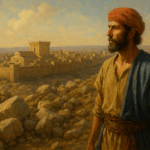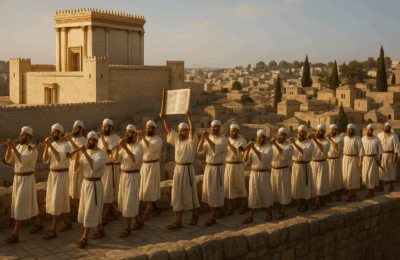Home | Bible Resources | Historical Books
Joshua | Judges | Ruth | 1 Samuel | 2 Samuel | 1 Kings | 2 Kings
1 Chronicles | 2 Chronicles | Ezra | Nehemiah | Esther
The Historical Books: From Conquest to Captivity — A Legacy of Kings, Covenant, and Consequences
Introduction: When the Promises Were Tested
What happens when God’s people step into the land He promised — but then forget the One who brought them there? The Historical Books (Joshua through Esther) answer that question with a raw and riveting chronicle of faith, failure, judgment, and hope. These twelve books span nearly a thousand years of redemptive history, chronicling Israel’s conquest of Canaan, the rise and fall of its kings, the tragic split of the kingdom, the devastation of exile, and the flickering light of restoration.
From the battlefield of Jericho to the royal court of Persia, from the triumphs of David to the tears of Jeremiah, this section of Scripture is nothing less than a theological biography of a nation — and a divine drama of covenant faithfulness.
Together, the Historical Books show us what it looks like when God’s people live in obedience — and what it costs when they don’t.
Overview: What Are the Historical Books?
The Historical Books consist of twelve Old Testament books that record the unfolding story of Israel from the conquest of Canaan (c. 1406 BC) to the post-exilic return under Persian rule (c. 430 BC). These books build on the Pentateuch’s foundation by documenting how the covenant community responded to God’s commands after entering the Promised Land.
Canonical Order:
Joshua, Judges, Ruth, 1 Samuel, 2 Samuel, 1 Kings, 2 Kings, 1 Chronicles, 2 Chronicles, Ezra, Nehemiah, Esther
Timeline:
📍 From the Conquest (Joshua) → to the Return (Ezra-Nehemiah) → to Preservation in Exile (Esther)
Covenantal Focus:
- Abrahamic Covenant — Land, seed, blessing (Gen. 12:1–3)
- Mosaic Covenant — Obedience brings blessing; disobedience brings judgment (Deut. 28)
- Davidic Covenant — A future King from David’s line will rule forever (2 Sam. 7)
Structure of the Historical Books
| Section | Books | Focus |
|---|---|---|
| Conquest & Settlement | Joshua, Judges, Ruth | Taking the land, surviving the cycle of sin, and glimpses of redemption |
| United Monarchy | 1 & 2 Samuel | The rise of kingship: Saul’s failure, David’s success |
| Divided Kingdom & Exile | 1 & 2 Kings | From Solomon’s splendor to national collapse and Babylonian captivity |
| Priestly Reframing | 1 & 2 Chronicles | A temple-centered retelling of Israel’s story to a post-exilic generation |
| Return and Restoration | Ezra, Nehemiah | Rebuilding Jerusalem’s temple, walls, and worship |
| Providence in Exile | Esther | God’s unseen hand protects His people behind palace walls |
See also: Chronology of End Times →
Book-by-Book Summary
Each book below links to a full-length teaching outline with theological commentary, typology, and discipleship application.
📘 Joshua
Theme: Conquest and Covenant Fulfillment
Summary: God gives Israel the land, but demands full obedience. Joshua leads with faith, but the seeds of compromise are already planted.
📘 Judges
Theme: The Cycle of Rebellion and Deliverance
Summary: Israel spirals into sin, idolatry, and chaos. God raises up judges, but “everyone did what was right in his own eyes.”
📘 Ruth
Theme: Redemption in the Days of Darkness
Summary: Amid Israel’s moral collapse, a Moabite widow becomes the ancestor of David — and of Christ. A quiet story with cosmic impact.
📘 1 Samuel
Theme: The Rise of Kingship
Summary: Israel demands a king like the nations. God gives Saul, then replaces him with David — a man after His own heart.
📘 2 Samuel
Theme: David’s Triumphs and Tragedies
Summary: David unites the kingdom and receives the covenant promise. Yet his sins ripple through generations.
📘 1 Kings
Theme: Glory to Division
Summary: Solomon builds the Temple and then breaks covenant. The kingdom fractures into north and south.
📘 2 Kings
Theme: Decline and Exile
Summary: Both kingdoms reject God. Prophets warn, kings rebel, and judgment comes through Assyria and Babylon.
📘 1 Chronicles
Theme: Davidic Hope for a Post-Exilic People
Summary: A retelling of David’s reign with priestly emphasis — reminding returning exiles of their spiritual identity.
📘 2 Chronicles
Theme: Temple, Kings, and Hope after Judgment
Summary: From Solomon to exile — a call to repent and rebuild. Ends with a Persian decree of return.
📘 Ezra
Theme: Return and Restoration
Summary: Zerubbabel and Ezra lead the people back. The temple rises again, but the people still need revival.
📘 Nehemiah
Theme: Rebuilding the Walls and the People
Summary: Nehemiah rebuilds Jerusalem’s walls — and calls for holiness, reform, and covenant renewal.
📘 Esther
Theme: Providence in Exile
Summary: God’s name is never mentioned — but His sovereignty is everywhere. A Persian queen risks everything to save God’s people.
Key Themes in the Historical Books
- God’s Sovereignty over Nations and Kings
- The Consequences of Covenant Unfaithfulness
- The Need for Righteous Leadership
- The Hope of the Davidic Promise
- God’s Hidden but Faithful Presence in Exile
- Typological Patterns of Christ (Joshua, David, Temple, Deliverance)
Why the Historical Books Matter Today
These books teach us how to walk with God when the culture is collapsing — and how to lead with courage in moments of national crisis, personal compromise, or spiritual exile. Whether rebuilding walls or weeping in ruins, we see God’s faithfulness unfold, one generation at a time.
These aren’t just stories of ancient kings and battles. They are divine case studies in courage, failure, repentance, and endurance. Through them, we learn to trust the true King — and walk with Him even when the world falls apart.











